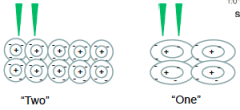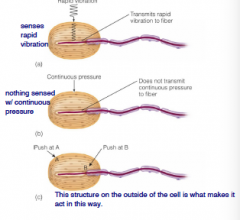![]()
![]()
![]()
Use LEFT and RIGHT arrow keys to navigate between flashcards;
Use UP and DOWN arrow keys to flip the card;
H to show hint;
A reads text to speech;
17 Cards in this Set
- Front
- Back
|
During tactile acuity tests, (groove and shape tests) which receptors fired the most and detected the pattern in the grooves or shape? Where on the body are these receptors densest? |
Merkel Disk Receptors detect the grooves or shape. They're most dense in the fingertips. (and are the closest to the surface of the skin) |
|
|
What causes increased tactile acuity and detail detection? |

A higher density of Merkel Disk Receptors. |
|
|
What is the Pacinian corpuscle responsible for sensing? Why is this? |

Pacinian Corpuscle = vibration. It has to do with the cell's physical structure - without it, it would respond to continuous pressure. |
|
|
What does the duplex theory of texture perception state? |
duplex theory of texture perception states that texture is determined by Merkel disk and Pacinian corpuscle repceptors. ---Merkel = spatial cues ---Pacinian = temporal cues |
|
|
What are two experiments that prove Pacinian receptor cells' importance in texture detection? |
1) temporal cues -- improved acuity when moving hand along surface to tell difference between fine & very fine textures 2) less acuity when fatigued |
|
|
What are the two major pathways in the spinal cord? |
Spinothalamic Pathway = smaller fibers for temperature and pain Medial Lemniscal Pathway = larger fibers for touch and proprioception |
|
|
How do signals get from the skin to the cortex? |
Signals go in bundles (peripheral nerves) along the dorsal root to the spinal cord, up one of the two pathways, and through the ventral posterolateral nucleus in the thalamus. |
|
|
Spinothalamic pathway. (in the spine) Is it large or small? What info does it carry?
|
Spinothalamic pathway: small. temperature and pain. (responsible for jerking hands away from hot temperatures before pain) |
|
|
Medial lemniscal pathway. (in the spine) Is it large or small? What info does it carry? |
medial lemniscal pathway: large. touch and proprioception. |
|
|
What part of the brain is somatotopic/topographic? What does this mean? |
The thalamus is somatopic/topographic. This means it's organized in the same way the receptors are. (thumb neurons next to palm neurons, lots of receptors means lots of neurons) |
|
|
After the thalamus, where do somatosensory signals go? |
thalamus --> S1 and S2 in the parietal lobe. (the primary and secondary receiving areas) |
|
|
What are the homunculi and where are they? What are they aka? |
The homunculi are body maps in S1 and S2 (in parietal lobe) that show that more cortical space is used by body parts that are responsible for detail. (aka Penfield Homunculus b/c he mapped out the motor and sensory cortices) |
|
|
What's significant about the somatosensory map and motor maps in the brain? |
Not only are they near each other, they match. |
|
|
What evidence is there for plasticity or modularity of the homunculus? |
Evidence of neural plasticity/experience dependent plasticity: --- monkeys trained on a task involving touching one fingertip, and that fingertip gained a greater representation in the cortical map! |
|
|
What happens to some violinists? (What is focal dystonia?) |
--As they use their fingers more, plasticity increases the size of the fingers' neural representation. --focal dystonia = areas responsible for sensing and controlling the fingers fuses, causing damage to finger motor control
|
|
|
What is Haptic Perception? Which 3 systems does it use? |
Haptic Perception = active exploration of 3-D objects with the hands. It uses 3 systems: --sensory system --motor system --cognitive system (for top down influence) |
|
|
How long does it take for people to haptically identify objects? What are the methods people use? |
1-2 seconds. uses: --lateral motion (circular motion with hands) --pressure (feeling hardness) --enclosure (putting hand(s) around it) --contour following (feeling edges) |

